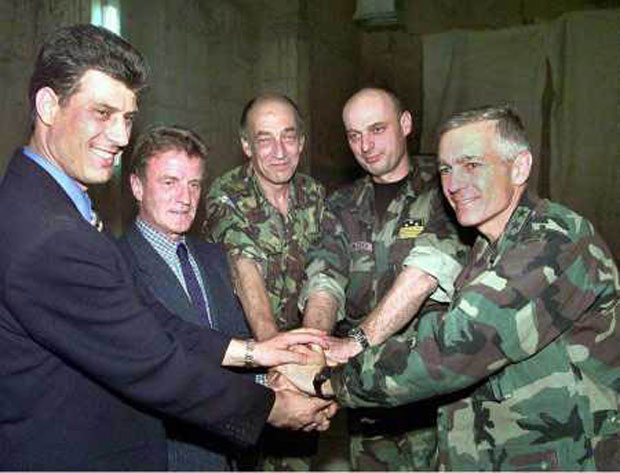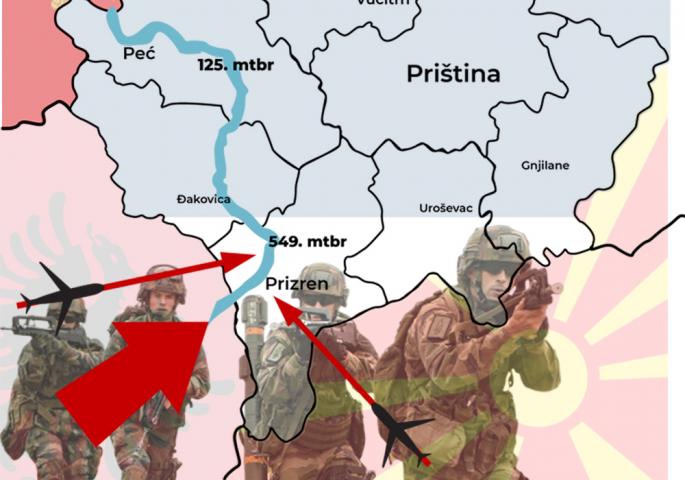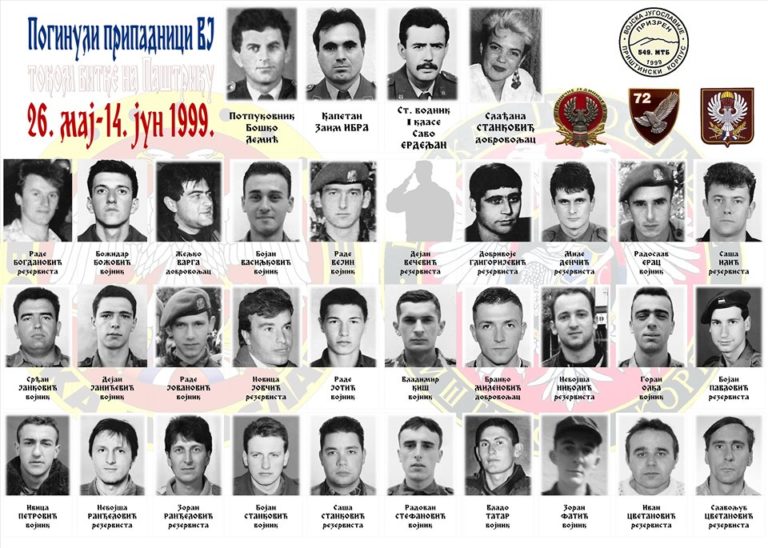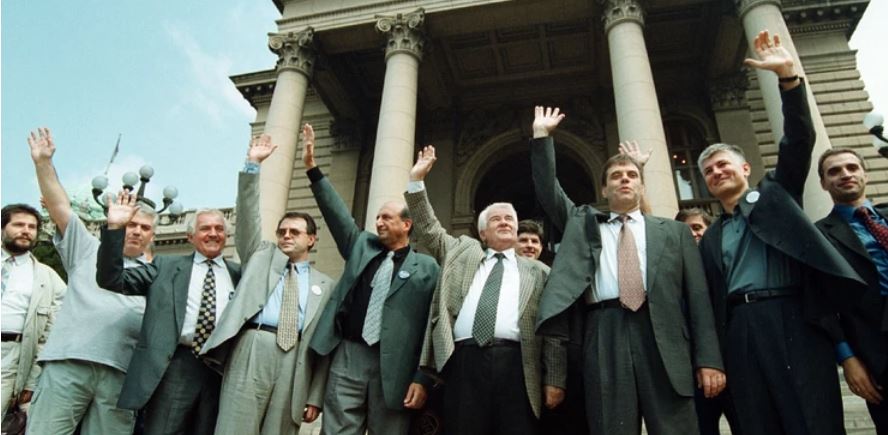Period:
Yugoslav Wars
Region:
Kosovo and Metohia
The Battle of Paštrik - Kosovo 1999
The Battle of Paštrik was a fierce battle between the Yugoslav Army and Albanian terrorists with their adherents, which took place in the southern parts of Kosovo and Metohija, along the border with the Republic of Albania during the 1999 NATO aggression.
This battle was recorded in the documents of the Third Army as the most difficult that the Army of Former Yugoslavia fought in its existence.
During the battle of Paštrik, the defense forces had about 1,500 soldiers, while the attacking forces had between 4,000 and 5,000 soldiers. The battle itself was code-named "Arrow 2”, and it began in the area of the Gorozup watchtower, near the village of Planeja, Prizren municipality. It started the morning of May 26, 1999, and lasted for more than two weeks.

The greatest contribution in stopping the invasion from the Republic of Albania, during this operation, was given by the members of the 549th Prizren Brigade, a unit that was awarded the Order of the People's Hero after the war.
The losses of the Yugoslav Army were small compared to the Kosovo Albanian Terrorist Group (in the further text- KLA) and their adherents, despite them having greater advantage on land, and even more in the air. Officially, 34 Yugoslav soldiers were killed and 126 were wounded.
BACKGROUND
The Federal Republic of Yugoslavia (1992-2003) was the third Yugoslavian state formed as a result of the disintegration of the Federal State of Yugoslavia, when Serbian and Montenegrian delegates proclaimed the constitution in Žabljak in April 1992.
At the same time, in the territory of the Federal State of Croatia, Croatian forces continued with their aggression against Krajina Serbs, who had formed their Republic of Serbian Krajina.
In Bosnia and Herzegovina, a bloody war was already in progress between Serbs, Muslims, and Croats. These conflicts ended in the Autumn of 1995 when the Dayton Peace Agreement was signed in the state of Ohio.
Soon, American military campaign became centered around assisting Albanian separatists from Kosovo and Metohija, providing them with weapons and logistics, and creating terrorist camps in Albania. This is when the Albanian terrorist group (KLA) was formed, whose members were illegally transported into the territory of Yugoslavia aimed at looting, trafficking, destabilization, and provocation of conflicts with the Police and Army of Yugoslavia.

Funeral of Serbian victims in Peć- December 1998.
In the Spring of 1998, conflicts between Albanian terrorists and members of Yugoslavian police intensified, resulting in the war, with a lot of casualties on both sides. Albanian terrorists were directly supported by the Western countries.
This support also included threats by the NATO that it would intervene in the conflict if Belgrade kept refusing to decrease the number of soldiers and policemen in Kosovo and Metohija.
In the Autumn of 1998, NATO began to bring its soldiers and technique to the Vardar Macedonia and Albania, while the “Milošević-Hoolbruk” agreement helped to prevent aggression against Serbia on 13 October 1998.
PLANS BEFORE THE BATTLE
Plans of the Attackers
The Battle on Paštrik came as a consequence of the defeat of Albanian terrorists, that is, the collapse of their "Arrow 1" operation, which took place near the Junički mountains, in the area of the Košara watchtower (some 70 km away northwest of the Gorozup watchtower).

American general Wesley Clark with KLA terrorists
NATO generals realized that they could not pass over the Junički mountains, as the terrain was very inconvenient and dangerous, while at the same time, the forces of the Yugoslav Army (members of the 125th Kosovo-Mitrovica Brigade) had already established themselves there. That is why the decision was made to find some easier terrain, so the choice fell on the valley of the river Beli Drim and the mountain Paštrik, believing that they would achieve their win there.
The goal of the aggressors in this operation was primarily to occupy the Prizren-Peja road, the town of Suva Reka, and then to reach Priština city. The KLA in the central, northern and eastern parts of Kosovo and Metohija were on the verge of defeat. They lacked manpower, ammunition, weapons, and equipment. During the spring of 1999, the Yugoslav Army and the Serbian Ministry of the Interior carried out a large scale operation in the entire area of Kosovo and Metohija, expelling the Albanian terrorist forces, helping the civilians begin to feel more safe and free.
In addition to the ground invasion, the aggressor's plans included the maximum support of NATO aviation. In addition to this, an additional plan was developed, in case of failure of this operation, they would embark on the land invasion of former Yugoslavia through Hungary, Bulgaria, (former Yugo) Macedonia, Romania and Bosnia and Herzegovina. But that meant significantly more engagement of new forces and heavy additional costs.
Defense plans
The command of the Priština Corps of the Yugoslav Army, based on the information it received from the Military Intelligence Service, realized that the enemy offensive in Košare was slowing down and that it would not bring the desired results to the attackers. It was believed that due to geostrategic conditions, the option of penetrating the Belodrim valley would be possible. That is why the area began to be mined. A minefield was built along the border with the Republic of Albania that stretched for a few kilometers. Anti-personnel and anti-tank mines were planted. In addition, the 549th Prizren Brigade was ordered to deploy and establish its positions in the area around Prizren.
POWER RELATIONS
During the Battle of Paštrik, the Yugoslav Army had about 1,500 soldiers in a direct collision: -The 549th Motorized Brigade from Prizren, under the command of then Colonel Božidar Delić.
-The 243rd Mechanized Brigade from Ferizaj, under the command of then Colonel Krsman Jelić.
-The 52nd Artillery Brigade from Đakova, under the command of then Colonel Miloš Đošan.
-The 72nd Special Brigade of the Military Police from Pančevo, under the command of Colonel Miroslav Talijan. There was also a small troop of Russian volunteers.
-The commander-in-chief of all defense forces in this battle was General Vladimir Lazarević, commander of the Priština Corps.

We are defenders of south Serbia
On the opposite side, the attackers had up to 5,000 fighters.
-The 137th “apparent” Brigade of the Kosovo Albanian terrorist group, under the command of Abdullah M. Babalji
-The 138th “apparent” Brigade of Kosovo Albanian terrorist group, also known as "Agim Ramadani", under the command of Rustem Berisha.
-The Second Division of the Republic of Albania
-SAS Special Unit from Great Britain
-US Marines
-Norwegian Special Forces
-The commander-in-chief of all aggressor forces was American General Wesley Clark, commander of the European NATO forces.
BATTLE DESCRIPTION
On Wednesday, May 26, 1999, in the early morning hours, about 1,000 well-armed terrorists from the KLA crossed the state border, approaching the positions of the 549th brigade from Prizren. There were about 450 soldiers in the operational zone. Around the Gorozup watchtower, there were close to 200 soldiers, the rest were on patrol duty and securing the border. Albanian terrorists used the “surprise” factor and started firing at the position of the 1st Battalion. The attack was stopped relatively quickly with the artillery support of 60 and 82 mm mortars, and the terrorists retreated to their initial positions. After a couple of hours, a new fierce wave of attacks started, and the defense used 122 and 152 mm howitzers, and two M-77 "Fire" missile batteries from the background.

Members of the Army of Yugoslavia who died during the battle
This was a successful defense since they destroyed much of the enemy’s manpower. It was an opportunity for the defense to rest, but also to change their position, due to the actions of NATO aviation. Albanian artillery operated in the depths of Yugoslav territory, but they had little impact. That is why NATO aviation became involved, which flew over the Serbian positions, mostly with drones, looking for artillery positions. Several hours of bombardment would follow after the flying of drones. After the artillery exchange of projectiles on both sides, the infantry attacks of terrorists in waves began in the afternoons. Yugoslav artillery changed the positions of the batteries, to cover the trail of NATO planes.
On the night between May 26th and 27th, night operations began. Albanian terrorists tried to find their way through the minefields but were destroyed. The first line of defense then numbered 65 soldiers and officers (but had a lack of ammunition.) After midnight, new artillery operations began in the reserve positions of the VJ. The infantry of the attack changed their tactics, so they moved on to quietly passing the positions of the 549th Brigade. Then, around 01:00, the terrorists opened infantry fire on the right-wing of the defense. The 1st Battalion did not react, to not reveal its new positions, and then a fierce attack and a close "hand-to-hand" fight started at a distance of 20- 30m. Although the terrorists had a numerical advantage, the attack was stopped by the defense throwing hand grenades on the orders of Art. Sergeant Žarko Petrović, after which the attackers retreated. At dawn the following day, the Albanian forces began to pull out their dead and wounded soldiers, and the Yugoslav Army did not act.
The NATO force command realized that the Albanian terrorists were not capable of carrying out their set plans, so they decided to send their infantry units to the front line to fight in support.
On May 28th, new waves of Albanian terrorists began to attack while NATO aviation provided support from the sky and bombed the positions of the Yugoslav army. They were stopped by the defense using "Bruds", made in Prizren, and they ejected a large number of metal shavings, where they wiped everything out at a range of 200-300 meters.
During the night, the popular "Apache" AN-64 used special helicopters. On May 29nd, over 150 drone flights were performed in the Paštrik zone, which filmed VJ positions.
This was done for two American B-52 bombers, which on May 30th attacked the village of Planeja below Prizren. One soldier was killed and 20 were wounded. Immediately afterward, an infantry attack of 400 Albanian terrorists started on Serbian positions. However, the attackers did not succeed in their intention here either.
The next day, Wednesday, May 31st, the heaviest and most numerous attack from Albania began. The defense was in an unenviable position due to a lack of food, ammunition, and great exhaustion due to constant attacks, both infantry, and air. The whole morning, until 2 pm, lasted a seven-hour battle, when over 1,000 terrorists stormed the VJ positions in waves.
NATO aviation only bombed the villages: Binaj, Planeja, and Ceja. Yugoslav soldiers again had a close fight with terrorists where they inflicted heavy losses, and 30 soldiers were wounded. However, the terrorists managed to sneak through the battle positions of the VJ and bury themselves in certain peaks of Paštrik. The artillery of the Yugoslav Army was in a very difficult situation, they were at the hands of NATO’s brutal and precise attacks. 4 soldiers were killed and one commander was wounded. The situation had become very serious.
A defense counterattack was launched and they managed to expel the terrorists from their positions. Support was also coming from the Vrbnica watchtower, with 82 mm mortars. In addition, a company of the Military Police, which acts with infantry fire, was inserted. It was only in the evening that the fighting stopped.

The consequence of inhumane NATO bombs:
exaggeration of Paštrik into "moon soil"
The first day of June 1999 brought new clashes on the front line. The special units of the 549th Brigade received an order to regain the peaks of Paštrik, which the American General Wesley Clark himself said must be maintained at all costs. In the following days, the attacks stopped, because the terrorists suffered heavy losses.
New strong artillery fire from Albania started on June 5th at the positions below Paštrik, and on that occasion, several soldiers were killed in an ambulance. Two days later, the B-52 bombers operated again on the positions of the Yugoslav army, but without much success.
Operation "Arrow 2" failed, and the terrorists and their adherents were defeated, despite the numerical and technical land and air advantage.
A side note: During this battle, Serbian officers used the tactics of making fake tanks. These models were bombed by NATO aviation. They were convinced that they were hitting real tanks.
THE END
On the evening of June 9th, 1999, the delegation of FR Yugoslavia went to Kumanovo, where military general Svetozar Marjanović and police general Obrad Stevanović signed a military-technical agreement with the NATO alliance, which meant the ending of NATO aggression and bombing of Serbia and Montenegro.

The signing of documents in Kumanovo
A day later, on June 10th, the UN Security Council in New York (USA) passed Resolution no. 1244, according to which the Army of Yugoslavia and the Police of Serbia, as well as the state administration, withdraw from the territory of the Autonomous Province of Kosovo and Metohija, while international forces: UNMIK and KFOR could take over the southern Serbian province. The KLA was to be formally disarmed, according to the agreements.
However, that did not stop the incessant Albanian violence against Kosovo-Metohija Serbs, while KFOR members were silent observers. Their homes, monasteries, and schools were burned and trashed. In June 1999, over 200,000 Serbs from the province fled the region for the northern parts of the Republic of Serbia, to escape the ethnic cleansing mission of the Albanian terrorists.
TESTIMONY
General Vladimir Lazarević, Commander of the Priština Corps:
"If the battle of Košare is synonymous with Vietnam in the small, then the battle of Paštrik is synonymous with Vietnam in the big."

Generals of the Yugoslav Army on the ground:
Nebojsa Pavković and Vladimir Lazarević
General Wesley Clark, Commander of the European Forces of the North Atlantic Alliance:
"NATO is fighting a capable adversary, whose units are skillfully changing their position and avoiding our aviation. The adversary has managed to smash all the larger KLA bases."
LOSSES
During this battle, the defense forces lost 34 soldiers, while 126 were wounded.
|
NAME
|
MILITARY RANK
|
BORN
|
HOMETOWN
|
|
Željko Saveta Varga |
Volunteer |
1966 |
Sr. Mitrovica |
|
Rade Jovan Jotić
|
Soldier |
1978 |
Zemun |
|
Branko Milutin Milenović
|
Reserve |
1975 |
- |
|
Ivica Dragoljub Petrović
|
Soldier |
1978 |
Priština |
|
Rade Milan Vejin
|
Soldier |
1977 |
Apatin |
|
Srđan Milovan Janković
|
Soldier |
1978 |
Vranje |
|
Zaim Gani Ibra
|
Captain |
1959
|
Prizren |
|
Dobrivoje Stanis. Gligorijević
|
Reserve |
1954 |
Prizren |
|
Bojan Novica Stanković
|
Reserve |
1974 |
Leskovac |
|
Radosav Rodoljub Erac
|
Soldier
|
1975 |
Kraljevo |
|
Boško Dušan Lemić
|
Regiment |
1952 |
Daruvar |
|
Vladimir Janko Kiš
|
Soldier
|
1978
|
Vrbas |
|
Dejan Aleksandar Janićijević
|
Soldier |
1978 |
Unknown |
|
Božidar Zlatan Božović
|
Soldier |
1979 |
Kos. Mitrovica |
|
Rade Nikola Bogdanović
|
Reserve |
1968 |
Lebane |
|
Mile Ratko Denčić
|
Reserve |
1967
|
Leskovac |
|
Novica Vukašin Jovčić
|
Reserve
|
1963 |
Lebane |
|
Nebojša Milenko Nikolić
|
Reserve |
1972
|
Prizren |
|
Nebojša Bogoljub Ranđelović
|
Reserve |
1967 |
Leskovac |
|
Saša Slobodan Stanković
|
Reserve
|
1970 |
Leskovac |
|
Ivan Dušan Cvetanović
|
Reserve
|
1960 |
Smed. Palanka |
|
Bojan Dragić Pavlović
|
Reserve
|
1974 |
Autsburg (DEU.) |
|
Saša Stane Ilić
|
Reserve |
1967
|
Unknown |
|
Zoran Tomislav Ranđelović
|
Reserve |
1966 |
Leskovac |
|
Goran Mate Olka
|
Reserve |
1978 |
Subotica |
|
Slavoljub Stojadin Cvetanović
|
Reserve
|
1962 |
Leskovac |
|
Slađana Veroljub Stanković
|
Volunteer |
1964 |
Niš |
|
Savo Milutin Erdeljan
|
Staff Sergean |
1961
|
Zrenjanin |
|
Rade Miroslav Jovanović
|
Soldier |
1979 |
Unknown |
|
Zoran Mile Fatić
|
Soldier |
1978 |
Andrijevica |
|
Bojan Dragan Vasiljković
|
Soldier |
1978 |
Niš |
|
Radovan Milorad Stefanović
|
Soldier |
1978 |
Prokuplje |
|
Dejan Stanimir Večević
|
Reserve |
1976 |
Prizren |
|
Vlado Miodrag Tatar
|
Soldier
|
1978 |
Đakovica |
The material losses of the 549th Brigade are as follows:
-two TAM 110 T7 trucks.
-one off-road vehicle “pinzgauer”
-two trucks with a water tank.
-two 120 mm mortars.
-one ambulance TAM 110.
According to the report of the 549th Brigade from Prizren, during the Battle of Paštrik, NATO aviation carried out 24 bombings of Yugoslav Army positions and on that occasion, 1,300 bombs were dropped, which is on average about 87 per day, or 350 tons of explosives in total. A-10 planes had 56 attacks on defense positions and dropped 22 bombs, then 20,000 depleted uranium missiles. Apache AN-64 helicopters acted in 8 attacks and fired over 50 guided and unguided missiles.
YEARS LATER
In October 2000, there were political changes of government in Serbia, where the leaders of the previous opposition took over the leadership of the state: Vojislav Koštunica, Zoran Djindjić, Vesna Pešić, Vladan Batić, Nenad Čanak, Goran Svilanović, Žarko Korać, Dragoljub Mićunović, Velimir Ilić, Miroljub Labus, etc. Their foreign policy was based on cooperation and "friendship" with NATO countries.

Leaders of DOS - Betrayal and Fraud of Serbia
The judicial authorities of the Republic of Serbia presented verdicts against NATO authorities Javier Solana, Wesley Clark, Richard Holbrooke, William Walker, deeming them responsible for falsifying reports that led to NATO aggression and crimes against innocent civilians. All of their verdicts and claims were declared invalid.
In addition, a large number of military and police officers from Serbia and Yugoslavia were extradited to The Hague tribunal, where most have been sentenced to life-long prison terms for alleged war crimes, mostly according to false witnesses found for that purpose.
During 2001-2004, there was a large purge of personnel in the Yugoslav Army and the Serbian Interior Ministry-one group retired and the other group was fired. This was done according to Western directives. Anyone who spoke publicly about the heroism of our fighters at the beginning of the 21st century, but also the victims, was persecuted by the secret police, and even arrested.
In mid-March 2004, Serbs from enclaves south of the Ibar were expelled in a great wave of Albanian violence known as the March pogrom.
Serbian fighters who defended their homeland in the 1990s have never received a worthy monument in the capital or any major city in Serbia. The social climate has only slightly improved since 2013.
Tags:
Please, vote for this article:
Visited: 4501 point
Number of votes: 16
|